
ProModeler 1/32 Bf-109G-4
|
KIT # |
? |
|
PRICE: |
$34.95 MSRP |
|
DECALS: |
Threeoptions |
|
REVIEWER: |
Tom Cleaver |
|
NOTES: |

|
HISTORY |
The Gustav Series:
The appearance of the Gustav series of Messerschmitt’s Bf-109 was due to the ineptness of the Luftwaffe high command in developing an acceptable production successor to the aging design, and reflected the lack of long-range planning on the part of the Third Reich for the war Hitler wanted. The highly-promising Fw-190 was just beginning its career, but it would never be able to match the high altitude performance of Messerschmitt’s product, which became more and more important as the war wore on and air combat occurred at ever-greater altitudes with the introduction of American daylight bombing. The Gustav series, which was produced in greater numbers than all the other versions combined, was actually the least of them all, since the design peak of the Bf-109 was the Friedrich series; the Gustav represented more and more weight added for less and less return. When first introduced into the Jadgwaffe in 1942, the Bf-109G was considered a retrograde step in development by the pilots. Heinz Knoke described the flying characteristics of the Gustav as “atrocious,” with the airplane having to be flown at full power in the landing circuit just to maintain altitude and maneuverability once the gear came down.
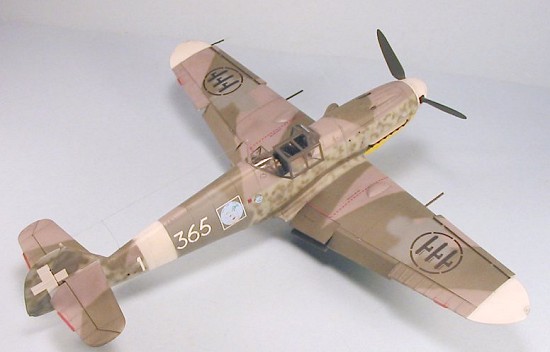 All the previous versions of the Bf-109 had mitigated the demand for
maximum possible speed with recognition of the importance of
maneuverability and handling. The higher power and weight loadings
represented by the Gustav series was considered acceptable in order to
achieve the increased emphasis on speed, despite the reduction in
maneuverability and handling capabilities.
All the previous versions of the Bf-109 had mitigated the demand for
maximum possible speed with recognition of the importance of
maneuverability and handling. The higher power and weight loadings
represented by the Gustav series was considered acceptable in order to
achieve the increased emphasis on speed, despite the reduction in
maneuverability and handling capabilities.
The DB605A engine that powered the Gustav series differed from the DB601E used for the Friedrich in having a redesigned cylinder block in which the maximum possible bore was obtained while retaining the original cylinder centers. Cylinder compression ratio was increased to 7.3 for the left cylinder block and 7.5 for the right. Maximum r.p.m. was increased to 2,800. The result was an engine with virtually unchanged overall dimensions, with take-off power increased to 1,475 h.p., with 1,355 h.p. available at 6,000 meters. GM 1, a system for injecting nitrous oxide into the engine at high altitude, had an enormous effect on performance, increasing output to 1,250 h.p. at 10,000 meters.
The Bf-109G also had a pressurized cockpit initially. This was a “cold wall” type in which the engine wall, cockpit floor and the sloping plate behind the pilot’s seat were all sealed, and designed to provide a pressure differential of 4.4 lb./sq.ft.
The system was only used in the Bf-109G-1 and Bf-109G-5; the others of the series lacked pressurization. (Add the G-3 to that list. Ed)
The first
Bf-109G to enter service in numbers was the Bf-109G-2, which first saw
combat over the Channel Front in the spring of 1942. The additional
weight of the Gustav required that the landing gear be beefed up; the G-4
version was the first to have “bumps” on the upper wing surface to fair
the increased size of the wheel well for the larger-size main wheels,
while a non-retractable tailwheel of increased size was also adopted. (Your
editor would like to point out that these are just
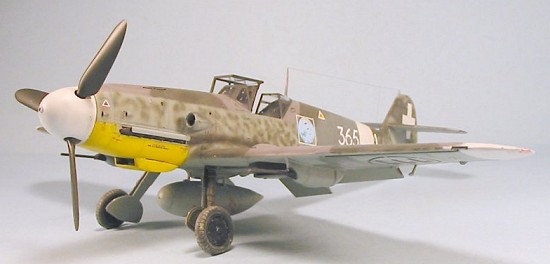 generalities as you
could find exceptions to the norm in just about any 109G variant. For
instance, the latest Classic Jagdwaffe book shows a G-2 with the
larger wheels and an early G-4 without the upper wing 'bumps'. This comes
from the common practice of upgrading damaged airframes to as close to
current standards as possible.)
These early Gustavs retained the engine-mounted 20mm MG 151 with two
7.92mm MG 17 machine guns in the forward fuselage, as developed for the
Friedrich series. This armament could be supplemented by
Rustsatze-6, which involved fitting an additional two MG 151s in
underwing gondolas just outboard of the wheel well; while this provided a
useful increase in weight of fire for anti-bomber operations, the
additional weight of the canons had a deleterious effect on
maneuverability of what the Germans called the Kannonenboot
(gunboat).
generalities as you
could find exceptions to the norm in just about any 109G variant. For
instance, the latest Classic Jagdwaffe book shows a G-2 with the
larger wheels and an early G-4 without the upper wing 'bumps'. This comes
from the common practice of upgrading damaged airframes to as close to
current standards as possible.)
These early Gustavs retained the engine-mounted 20mm MG 151 with two
7.92mm MG 17 machine guns in the forward fuselage, as developed for the
Friedrich series. This armament could be supplemented by
Rustsatze-6, which involved fitting an additional two MG 151s in
underwing gondolas just outboard of the wheel well; while this provided a
useful increase in weight of fire for anti-bomber operations, the
additional weight of the canons had a deleterious effect on
maneuverability of what the Germans called the Kannonenboot
(gunboat).
With the Bf-109 being mass-produced, the Gustav was the first of the 109s to widely equip other Axis air forces, whose domestic aircraft industries were either non-existent or unable to produce modern fighters in sufficient numbers for their air forces to meet the Allies in combat on an equal footing. The first of these allied air forces to obtain the Bf-109G was that of Finland, commencing in January 1943. The Finns were followed shortly by the Hungarians and the Romanians during the spring of 1943.
Following the
defeat of Axis forces in North Africa in early 1943, the Regia
Aeronautica was forced to admit that while the Italian aircraft
industry could produce first-class fighters such as the Macchi C.202 and
Reggianne 2001, the industry could not possibly produce these aircraft in
sufficient numbers to maintain attrition, let alone embark on expansion.
Thus, the Italians too were forced to turn to Germany for more modern
fighters. In May 1943, 3rd Grupo exchanged its
surviving C.202 Folgore fighters for Bf-109G-4s, most of which
were the Bf-109G-4/R6 version with the two underwing 20mm cannon. During
 the next two months of operations, losses would be replaced with
Bf-109G-6/R6 aircraft. When the Allies began the Pantellaria campaign in
mid-May, at least one Squadriglia was able to enter combat in the
bomber-interception role, though losses against Allied fighters were
heavy. Following the surrender of the garrison on Pantellaria, the Sicily
campaign began in earnest. 3rd Grupo was joined by the
similarly-equipped 150th Grupo, composed of the 364th
a and 365th Squadriglia, in early June. Allied bombers
were well-escorted by fighters from Tunisia and Malta, and major
dogfights erupted over Sicily daily.
the next two months of operations, losses would be replaced with
Bf-109G-6/R6 aircraft. When the Allies began the Pantellaria campaign in
mid-May, at least one Squadriglia was able to enter combat in the
bomber-interception role, though losses against Allied fighters were
heavy. Following the surrender of the garrison on Pantellaria, the Sicily
campaign began in earnest. 3rd Grupo was joined by the
similarly-equipped 150th Grupo, composed of the 364th
a and 365th Squadriglia, in early June. Allied bombers
were well-escorted by fighters from Tunisia and Malta, and major
dogfights erupted over Sicily daily.
Conditions in Sicily were chaotic on the Axis side. Most prominent was the failure to establish a centralized fighter control; German and Italian units continued to operate as if the other was not present. On July 3, 1943, the Bf-109Gs of 150th Grupo intercepted Baltimore and Boston bombers of the Desert Air Force, escorted by P-40s from a “green” American unit. Three bombers and seven fighters were claimed shot down, for the loss of one Bf-109. 150th Grupo gained further successes before the invasion, becoming the most successful unit of the Regia Aeronautica to use the Bf-109G. This was all for naught, because the Allied invasion on July 10 saw both Gruppi of 109s virtually wiped out on the ground due to Allied air attacks on their bases. Surviving pilots of the units managed to evacuate to the mainland, where many would eventually fly the Bf-109G again, as members of the Aviazione della R.S.I.
|
THE KIT |
 Hasegawa’s 1/32
Bf-109 kit in its many guises is well-reviewed in several articles. This
kit, released through Pro-Modeler as part of a production and
distribution agreement with Revell of Germany, has a new sprue for the
different upper cowling and the different machine guns, as well as a set
of earlier resin wheels so that the Bf-109G-2 can be made from the kit.
Interestingly, this sprue is labeled “Bf-109F,” which is certainly a
strong indication of what the next series of kits will be now that
Hasegawa has finished the Gustav and Kurfurst series. Bring
on the Friedrich, I say!
Hasegawa’s 1/32
Bf-109 kit in its many guises is well-reviewed in several articles. This
kit, released through Pro-Modeler as part of a production and
distribution agreement with Revell of Germany, has a new sprue for the
different upper cowling and the different machine guns, as well as a set
of earlier resin wheels so that the Bf-109G-2 can be made from the kit.
Interestingly, this sprue is labeled “Bf-109F,” which is certainly a
strong indication of what the next series of kits will be now that
Hasegawa has finished the Gustav and Kurfurst series. Bring
on the Friedrich, I say!
As with all the other kits in this series, the modeler gets a fairly simple kit which provides an acceptable cockpit, is basically correct in outline and detail, without such “extras” as engines and other things most modelers wouldn’t use anyway. The result is an inexpensive kit (this one cost $19.99 from Squadron, about as big a bargain as it is possible to find), which allows a modeler to afford to have more than one in the collection, a good thing given the myriad of paint schemes and markings that are possible. For the serious 109nutz, there are plenty of aftermarket sets for the cockpit, the engine, and just about anything else one can imagine, as well as a real plethora of decals. I personally wish the other manufacturers who are considering entering the 1/32 kit field would observe the success of this strategy and follow up similarly.
|
CONSTRUCTION |
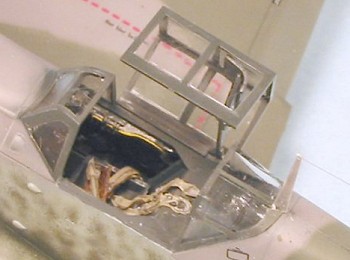 For me, the big
difference between this kit and the other 1/32 Bf-109s in my collection
was that I did not use a resin cockpit. This wasn’t because I didn’t
have one ready, but because I decided to see just what one would get with
a closer out-of-the-box project. The one concession to the aftermarket
was the use of Cutting Edge posable resin seat belts; to me, if you do
nothing more than dress up the seat of a moderately-detailed cockpit, you
can improve the look a hundred percent. Interestingly, once completed
and compared with another model, the Awful Truth emerged: from a foot
away, it’s just about impossible to tell the difference between the two
cockpits! Yes, go in close and the differences become obvious, but if
your main interest in building the kit is for markings and paint scheme,
you really can get away with saving $20 on a resin cockpit - money you
can put toward buying another kit!
For me, the big
difference between this kit and the other 1/32 Bf-109s in my collection
was that I did not use a resin cockpit. This wasn’t because I didn’t
have one ready, but because I decided to see just what one would get with
a closer out-of-the-box project. The one concession to the aftermarket
was the use of Cutting Edge posable resin seat belts; to me, if you do
nothing more than dress up the seat of a moderately-detailed cockpit, you
can improve the look a hundred percent. Interestingly, once completed
and compared with another model, the Awful Truth emerged: from a foot
away, it’s just about impossible to tell the difference between the two
cockpits! Yes, go in close and the differences become obvious, but if
your main interest in building the kit is for markings and paint scheme,
you really can get away with saving $20 on a resin cockpit - money you
can put toward buying another kit!
As far as construction of the rest of the kit is concerned, what can I say? Hasegawa has taken the “shake and bake” production design philosophy to its ultimate expression with these Bf-109 kits and their fellow Fw-190s. If you follow the instructions, it is just about impossible to screw up the construction of the model. Everything fits closely enough that I only used some Mr. Surfacer on the centerline seams in the nose area and along the leading edges of the wings.
|
COLORS & MARKINGS |
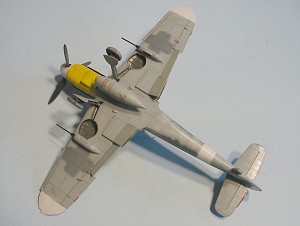 Painting:
Painting:
The Regia
Aeronautica Bf-109s were simply Luftwaffe aircraft that came in
standard markings, which were overpainted and Italian markings provided.
Thus, I did an “Augsburg scheme” camouflage pattern, RLM74 AND rlm75
upper colors, RLM76 lower colors, and a fuselage mottle of RLM02, RLM71
and RLM74. This was applied after pre-shading the model with flat black
along the panel lines, and I used Gunze-Sangyo “German Field Grey” for
the RLM74, Gunze “Medium Sea Grey” for the RLM75, Gunze RLM76, and RLM71
with Tamiya RLM02 for the mottle. After this was dry, I used a mixture
approximating Italian “Azure Grey” to overpaint the areas
 of the German
national markings. Mediterranean Theater ID markings of white spinner,
white fuselage stripe and white wing tips was done with Tamiya Flat White
and masked off before applying the camouflage pattern. When all was dry,
I gave the model a coat of Future.
of the German
national markings. Mediterranean Theater ID markings of white spinner,
white fuselage stripe and white wing tips was done with Tamiya Flat White
and masked off before applying the camouflage pattern. When all was dry,
I gave the model a coat of Future.
Decals:
I used the decals from Aeromaster 32-038, which has markings for two Regia Aeronautica Bf-109G-6s of 150th Grupo - I did a cut-and-paste with the side numbers to create a Bf-109G-4/R6 that is shown in profile on a Third Group Decals sheet of Regia Aeronautica and Aviazione Della R.S.I. Bf-109s.
|
FINAL CONSTRUCTION |
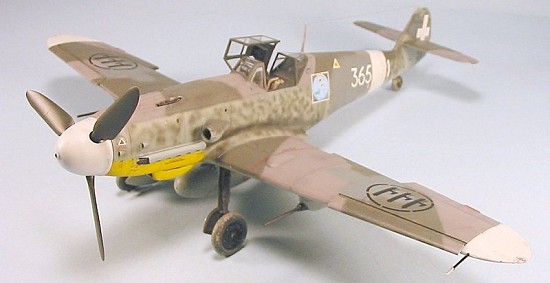 Photos of
these Bf-109s do not show them badly worn, though they were ex-service
machines from the German Luftwaffe that had been reconditioned before
being transferred to the Italians. They also didn’t see an extended
period of combat service, so I minimized chips and dings and applied
exhaust and oil stains. Two coats of thinned Dullcote gave the final
finish I wanted. I then unmasked the canopy and attached the center
section in the open position. The antenna wire is made with nylon
“invisible thread.”
Photos of
these Bf-109s do not show them badly worn, though they were ex-service
machines from the German Luftwaffe that had been reconditioned before
being transferred to the Italians. They also didn’t see an extended
period of combat service, so I minimized chips and dings and applied
exhaust and oil stains. Two coats of thinned Dullcote gave the final
finish I wanted. I then unmasked the canopy and attached the center
section in the open position. The antenna wire is made with nylon
“invisible thread.”
|
CONCLUSIONS |
Another 109 in one of the many markings possibilities for this airplane that served with every Axis air force on all fronts. These Hasegawa kits have made me a believer in Big Models for certain projects.
June 2004
Copyright ModelingMadness.com
Kit courtesy of my wallet.
If you would like your product reviewed fairly and fairly quickly, please contact the editor or see other details in the Note to Contributors.